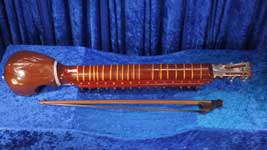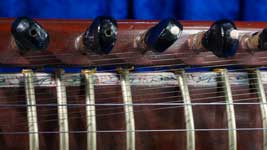
Esraj is a combination between saringda and sitar. The base of the instrument is like saringda while the neck and strings are like sitar. It gives a sound very much like sarangi without being as difficult to play. This instrument is often confused with dilruba. Both have a similar construction and technique. The approach to tuning is somewhat similar to the sitar. The esraj is popular in the Bengal area of India.
Technique
The technique is also a cross between the saringda and the sitar. It is bowed with a bow (known as gaz) in a manner very much like the sarangi. It is bowed with the right hand while the left hand fingers the strings.

There seem to be two schools concerning the fingering of the esraj. One approach shows a strong influence of the sitar. For this approach, there is a strong preference given to using the index finger. Like the sitar, one occasionally invokes the middle finger to gain speed. This approach seems to be slightly more common in North Eastern India. The other school of seems to show more of an influence from the sarangi. For this approach there is a distinct preference given to the use of the middle finger coupled with the index finger. This approach seems to have the advantage that if one requires speed, one can occasionally use either the index or the ring finger to go in either direction. It is interesting to note though that the proponents of the “sarangi” school of technique seem to be less disposed to invoke such shortcuts to their technique.
In either case, one does not solidly lock the string against the fret as one would do with the sitar or most other fretted stringed instruments. One only has to lightly touch the fret against the string. This allows one to alter the intonation with ease. One has no problem raising or lowering the pitch at the fret simply by where on the fret you wish to place the finger. In short, we can think of the frets of the esraj as being mere guides for correct finger placement.
The layout of the strings of the esraj is very similar to the sitar. This is shown in the illustration to the right. However unlike the sitar, there is no need to move the frets whenever one is playing a note that does not have a fret (e.g., Komal Re or Komal Dha in the middle register.) When one needs to play these notes, one merely has to place the finger in the appropriate point midway between the frets.
The meend is also produced in a fashion very differently from the sitar. For the dilruba, one need only slide the fingers up and down along the string in order to produce a meend or any other ornament, where on the sitar one pulls the string laterally across the fret.
| THESE BOOKS MAY NOT BE FOR YOU |
|---|
A superficial exposure to music is acceptable to most people; but there is an elite for whom this is not enough. If you have attained certain social and intellectual level, Elementary North Indian Vocal (Vol 1-2) may be for you. This has compositions, theory, history, and other topics. All exercises and compositions have audio material which may be streamed over the internet for free. It is available in a variety of formats to accommodate every budget. Are you really ready to step up to the next level? Check your local Amazon. |
Photo Gallery
Click on the image.

Esraj

Esraj back

Esraj base

Upper part of neck

Tuning keys

Side view of neck

Bridge

Taraf strings

String attachment to tuning pegs

Upper bridge

String attachment at base
Selected Video
Navigation
| Stringing and Tuning The Dilruba and Esraj: Quickguide – A quick approach to tuning and stringing the esraj and dilruba. Stringing and Tuning the Dilruba and Esraj – Introduction to an in-depth discussion of tuning and stringing. Rosin – Detailed look at the rosin. |